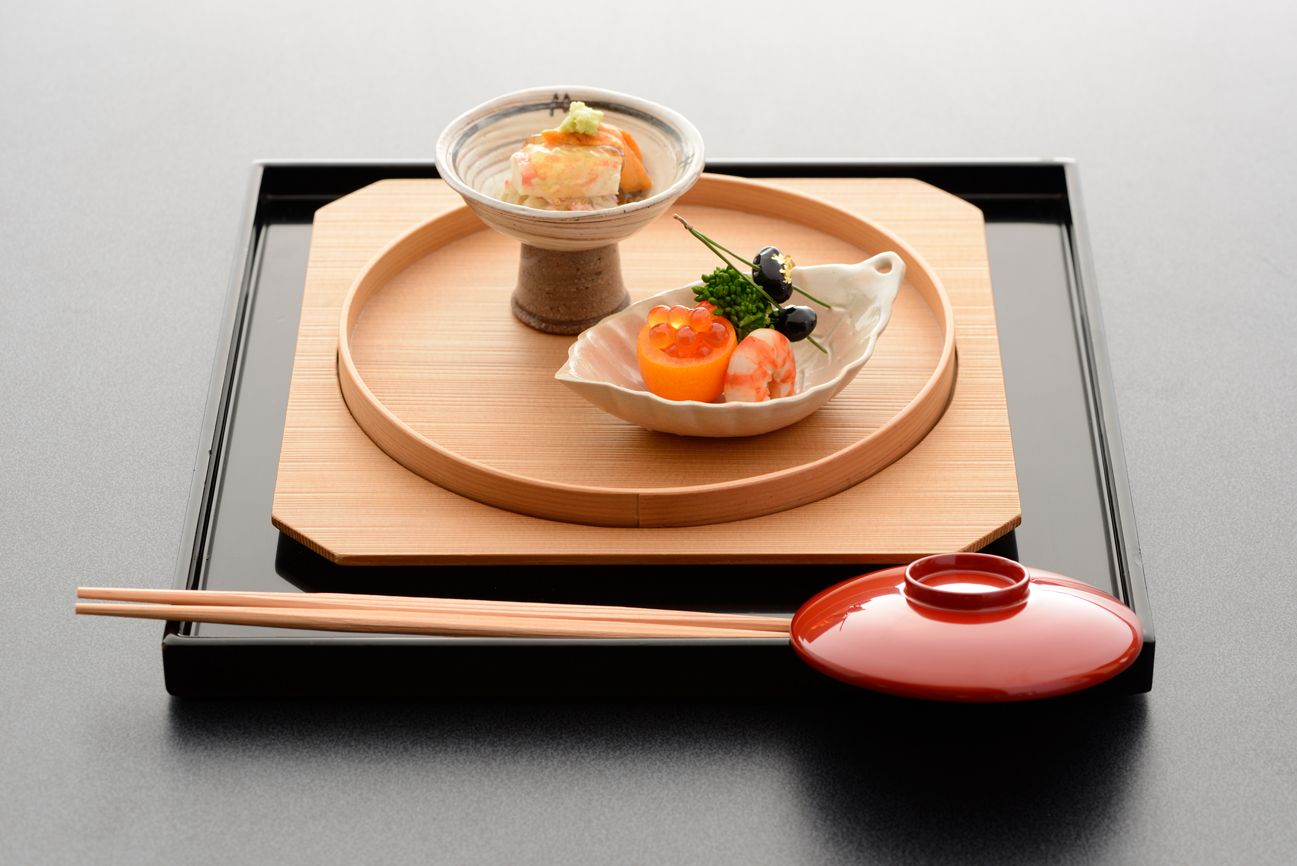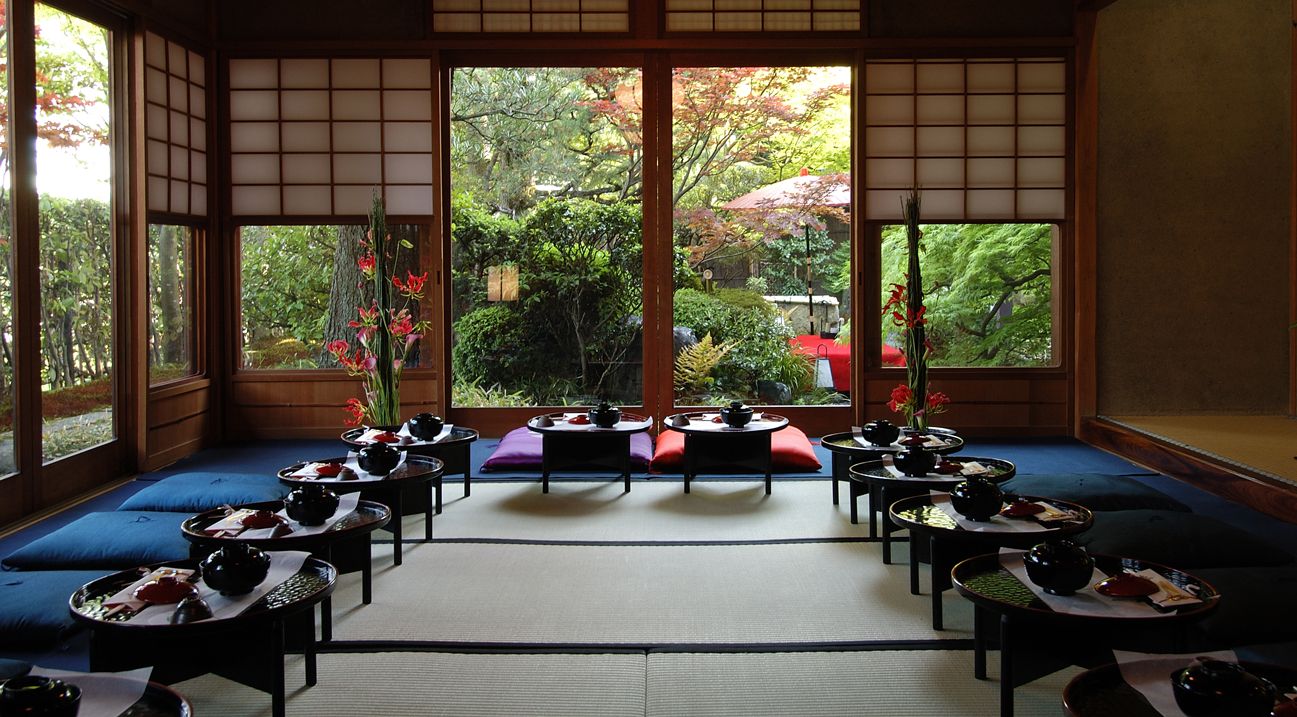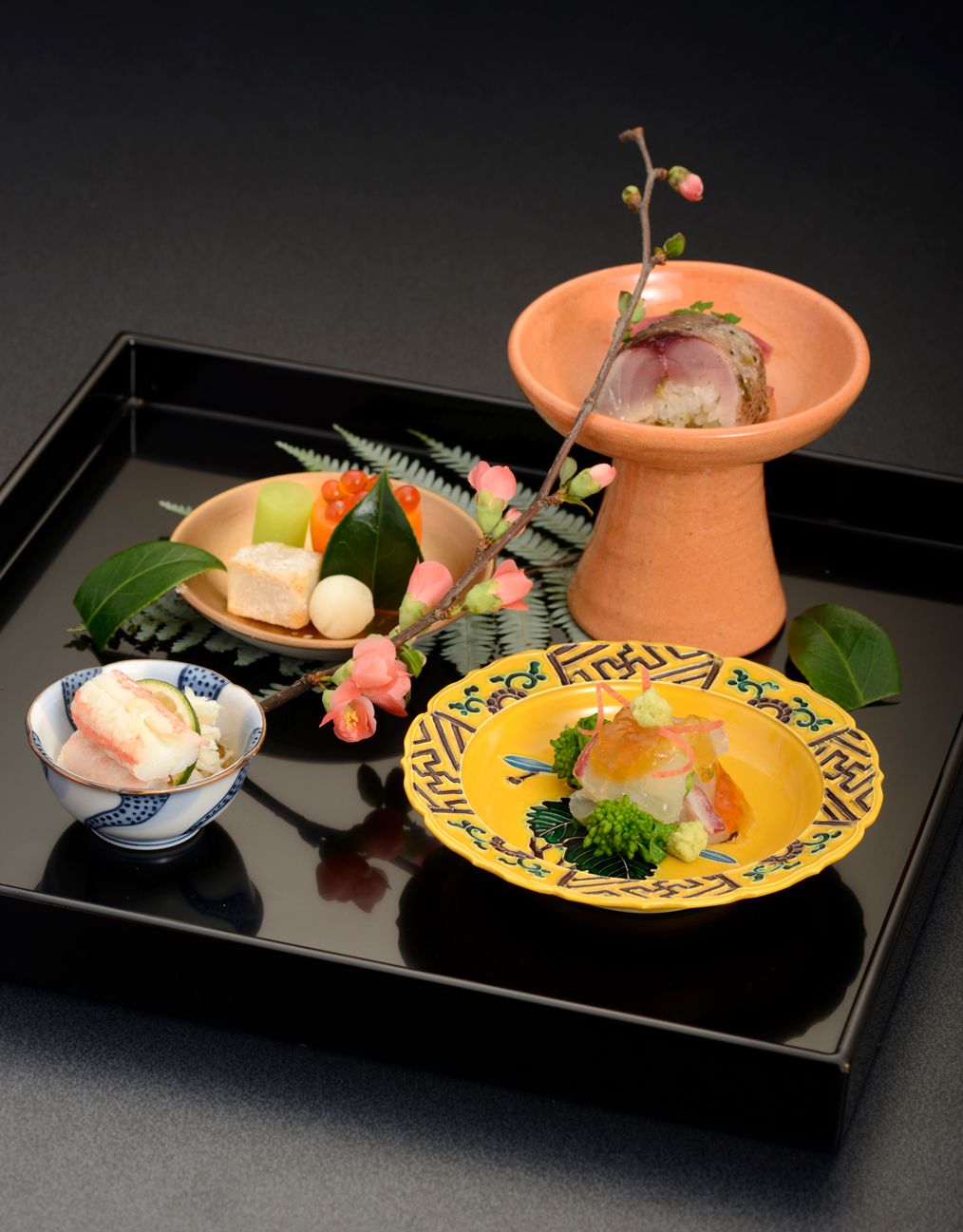
How to enjoy Kaiseki course cuisine, giving thanks to the blessings of nature
Registered as a UNESCO intangible cultural heritage, Washoku influences chefs around the world. In particular, Kaiseki course cuisine, representative of Japanese Omotenashi cuisine, is based on the hospitality of ensuring guests enjoy the season with all five senses. Mr. Kundo Koyama is owner of Kyoto restaurant “Shimogamo Saryo” which has continued for nearly 160 years, and is engaged as food-theme project producer for Expo 2025 in Japan. I also talked to Mr. Naotaka Motoyama, executive chef of “Shimogamo Saryo”, about Kaiseki course cuisine, said to be the origin of Japanese cuisine.

The ryotei restaurant is a fitting place for family celebrations and entertaining people important to you. The cuisine is carried dish by dish to the individual dining table in front of each person.
Kaiseki cuisine refers to cuisine eaten at the tea ceremony before tea is served. Devised by Sen no Rikyu who became known for Wabicha (an austere-style tea ceremony) in the Azuchi-Momoyama Period (1568-1600), it originates in the meal served at the tea ceremony. The style of offering dishes one at a time as they become ready, in order for warm things to be eaten warm, and cold things cold, is the basis of Japanese cuisine. Later, in the Edo Period, a Kaiseki cuisine, written with different characters, was born separate from the tea ceremony and was for enjoying cuisine by professional chefs at informal banquets. This has been widely inherited in the present day. In the present day, Kaiseki cuisine can be enjoyed at restaurants called “ryotei” using traditional Japanese facilities, and they are often used for family celebrations, business functions, etc.
Mr. Koyama talks about the way to enjoy time at a ryotei restaurant, a concentration of the aesthetics of Japanese cuisine. “There is no need to think that a ryotei is stiff and formal. Foremost, enjoy the season with all five of your senses. From the moment you enter the door, there are many points giving a sense of the season, such as the installed garden scenery and entrance hall, or calligraphy and flower arrangement in the special alcove. Regarding the cuisine, too, the flavors as well as the serving style, vessels, etc. incorporate a sense of the season. You can see it with your eyes, enjoy it to the full through aroma, food texture, and sometimes even sound, and this all creates a special time. Don’t hesitate to ask the staff if there’s something you don’t understand, like how to handle the chopsticks or vessels, or the way to read the hanging scroll. It is from there that communication is born”.

All areas of a ryotei - entrance hall, special alcove, garden, etc. - are arranged according to the season.

The garden landscape, which changes season by season, softens the feelings of the guests before the meal.
Mr. Koyama, who is often involved in conveying the appeal of Washoku for other countries, says that the distinctive feature of Washoku lies in “umami” savoriness. “Japanese cuisine has gradations of flavor. Western cuisine adds layers of flavors with sauce on the food, or seasons dishes simply with salt. Japanese cuisine, however, creates depth and expression using vegetable-based stock from kombu seaweed, dried shiitake mushroom, etc. I think that’s the greatest characteristic”
On the other hand, of importance in expressing a sense of the season in cuisine is the selection of seasonal ingredients and use of the knife. Shimogamo Saryo puts importance on the sense of season by incorporating mainly local traditional vegetables known as “Kyo yasai”. It actively uses the vegetables grown in Kyoto since olden times. For example, distinctively vivid, bright red Kyoto carrots in winter, bamboo shoots heralding spring, Kamo eggplants with their watery texture and Shishigatani pumpkins that are simple and elegantly flavored in summer, and Tanba chestnuts with a light, dry texture and fragrant, sweet taste in the fall. Shaping vegetables into the scenery of the season to give dishes a sense of the season is a knife technique called “kazari-kiri (decorative cutting)”. Carrots garnishing a bowl are also arranged to please as plum or cherry blossoms, colored leaves, etc. according to the season. According to head chef Mr. Motoyama, many years of training is needed to use knives properly. “Japanese cuisine uses different knives depending on the variety of vegetable or fish. It takes five years to be able to use all the numerous types of knife, including Usuba, Deba and Yanagi”. The Usuba knife cuts vegetables, the Deba knife dissects fish and chicken, and the Yanagiba knife cuts sashimi beautifully. Using these and others, the knife techniques for cutting ingredients beautifully and without waste greatly impact the appearance and taste of the cuisine.

“Hassun”, servings of small amounts of various cuisine using seasonal ingredients.

Sense of the season is expressed with garnishes of seasonal plants, etc. on the beautifully uniformly-cut cuisine.

Conger eel is an essential ingredient in Kyoto cuisine. Pre-preparation called “hone-kiri” is done to cut up the countless small bones. There is a specialized knife, and it requires proficient skill.
Matching a vessel to the cuisine is also the chef’s chance to show their abilities. “In the same way that food changes by season and event, food vessels, too, should change accordingly. Vessels have diverse shapes and patterns that include plants, animals and geometric patterns, and in the restaurant they are used to suit different purposes for the customer”, says Mr. Motoyama. Also, the impression of the cuisine can change depending on the material of the vessel. “Translucent porcelain vessels are often delicate and lustrous with colorful pictures, etc., while ceramic vessels have warmth with a unique feel and quality. Also, lacquer vessels don’t just feel good, but taste good, and bring out the deliciousness of the cuisine to the full. Their luster improves over many years of careful use, and they transform to a deep hue”. For example, porcelain vessels for cold dishes such as appetizers and sashimi, ceramic vessels for grilled dishes, lacquer vessels - with excellent insulation - for hot soups. Among these and others, vessels are combined according to dish and season.

Grilled dishes are served in ceramic vessels that give a feeling of warmth.

Hot soup is provided in a lacquer bowl so that it’s easy to hold in the hand.
Ryotei aren’t just places to eat delicious food, says Mr. Koyama. “Although the content of cuisine changes with the era, at the base of it all is respect for nature”. The Japanese are people who worshipped nature since olden times, and have a consciousness of living within nature. For that reason, it is important that cuisine is a way to give thanks to the food that is the blessing of nature. The act of cherishing the four seasons is our thanks toward nature, and a ryotei is where that feeling reaches the customer through the cuisine”
The Kaiseki cuisine served by Rikyu was in no way luxurious, using seasonal foods near to hand and made considering eatable amounts. That style of offering “eat-all” dishes one by one in order is inherited by ryotei of the present day, too. Mr. Motoyama speaks about the way to select ingredients. “In Japan, when it comes to fish, there are many people who prefer them to be wild, and there is a tendency to go after wild fish that has become rare in present times. From now on I think chefs, too, must take the view of the conservation of marine resources, and rethink their choice of ingredients rather than insist on the sort of fish that are endangered species. I make every effort to utilize my food preparation skills to maintain the quality while using bred fish as appropriate”
In Japan, people say “Itadakimasu” before a meal: it contains the meaning of thanking nature through the act of eating, says Mr. Koyama. “Many people are now beginning to realize that there are limits to the food that we put in our mouths. At ryotei, we want those gathered together to share gentle feelings, while sensing that a meal time, which we normally take for granted, is in fact a miraculous moment. Through the experience of being present in this space that is tradition, I hope the every day will become richer”
Kundo Koyama
Born in Kumamoto Prefecture in 1964. Broadcast writer, script writer. Vice-president, Kyoto University of the Arts. Involved in numerous TV programs including “Ryori no Tetsujin (Iron Chef)”, “Sekai Isan (World Heritage)”, and was awarded the Japan Academy Awards Best Script Prize for the movie Okuribito (Departures). Also the creator of Kumamoto Prefecture’s mascot character, “Kumamon”. In addition to writing activities, is regional and business adviser and owner of restaurant, Shimogamo Saryo. Appointed food-theme project producer for Expo 2025 Osaka, Kansai, Japan.
https://www.n35.co.jp/
Naotaka Motoyama
Born in Saga Prefecture in 1981. Influenced by chef father, he decided on the same path as him, and gained much training at Japanese restaurants in Tokyo. In March 2016, he became head chef at “Ginza Shimogamo Saryo Higashi no hanare” on the opening of Tokyu Plaza Ginza, and in June 2017, appointed executive chef at Kyoto “Shimogamo Saryo”. Responsible for the kitchens of both Kyoto and Ginza restaurants.
https://www.shimogamosaryo.co.jp/
Related articles:
Authentic Kaiseki course cuisine restaurant “Roketsu” has opened in London, brought by chef of Kyoto cuisine, Mr. Daisuke Hayashi
/en/feature/detail/258.html
Savoring the seasons of Japan without time lag at the famous restaurant of the top sushi chef in Singapore
/en/feature/detail/630.html
Serving a Delicious Dining Experience with a Rich Array of Tableware Borne of Japanese Beauty
/en/feature/detail/272.html
Photos supplied by: Shimogamo Saryo
Text: Junko Kubodera






